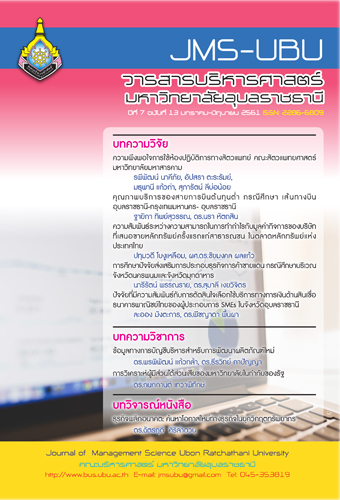การวิเคราะห์ผู้มีส่วนได้ส่วนเสียของมหาวิทยาลัยในกำกับของรัฐ
Main Article Content
บทคัดย่อ
บทความนี้วิเคราะห์ผู้มีส่วนได้ส่วนเสียของมหาวิทยาลัยที่กำลังจะออกนอกระบบไปเป็นมหาวิทยาลัยในกำกับของรัฐโดยใช้การวิเคราะห์ความสำคัญของผู้มีส่วนได้ส่วนเสีย (Stakeholder Salience) ซึ่งจำแนกคุณลักษณะของผู้มีส่วนได้ส่วนเสียออกเป็นอำนาจ ความชอบธรรมและความเร่งด่วน ผู้มีส่วนได้ส่วนเสียของมหาวิทยาลัยในกำกับของรัฐ ได้แก่ นักศึกษา อาจารย์ พนักงานสายสนับสนุนวิชาการ ผู้บริหารมหาวิทยาลัย สภามหาวิทยาลัย แหล่งทุนของมหาวิทยาลัย บริษัท/นายจ้าง รัฐบาลและหน่วยงานตรวจสอบ จากการวิเคราะห์พบว่าผู้มีส่วนได้ส่วนเสียที่มีความสำคัญที่สุดเป็นผู้มีส่วนได้ส่วนเสียภายในองค์กร ได้แก่ นักศึกษา อาจารย์ พนักงานสายสนับสนุนวิชาการ ผู้บริหารมหาวิทยาลัยและสภามหาวิทยาลัย เนื่องจากเป็นกลุ่มที่มีทั้งอำนาจ ความชอบธรรมและความเร่งด่วน ดังนั้น เมื่อมหาวิทยาลัยมีการเปลี่ยนแปลงเป็นมหาวิทยาลัยในกำกับแล้ว ควรจะแก้ไขสิ่งที่เป็นความเร่งด่วนของผู้มีส่วนได้ส่วนเสียกลุ่มดังกล่าว เช่น ความกังวลในเรื่องการเพิ่มขึ้นของค่าธรรมเนียมการศึกษา ความมั่นคงของอาชีพ ความเพียงพอของสวัสดิการของพนักงาน คุณภาพการเรียนการสอนและคุณภาพบัณฑิต การหารายได้เพื่อให้เพียงพอกับรายจ่ายที่เพิ่มขึ้นของมหาวิทยาลัย การสร้างระบบและกฎเกณฑ์ต่างๆ เพื่อรองรับการเปลี่ยนแปลง การใช้หลักธรรมาภิบาลในการตรวจสอบ เพื่อให้มหาวิทยาลัยสามารถดำเนินงานให้บรรลุวัตถุประสงค์ต่อไป
Downloads
Article Details
บทความที่ตีพิมพ์ในวารสารบริหารศาสตร์ มหาวิทยาลัยอุบลราชธานี เป็นลิขสิทธิ์ของวารสาร โดยเนื้อหาและความคิดเห็นในบทความเป็นความรับผิดชอบของผู้เขียนแต่ละท่าน ไม่เกี่ยวข้องกับคณะบริหารศาสตร์ มหาวิทยาลัยอุบลราชธานีแต่อย่างใด และหากมีข้อผิดพลาดประการใด ผู้เขียนจะเป็นผู้รับผิดชอบต่อบทความของตนเองแต่เพียงผู้เดียว
เอกสารอ้างอิง
เทียนฉาย กีระนันท์. (2545). รายงานวิจัยฉบับสมบูรณ์โครงการวิจัยเรื่องการเตรียมพร้อมของมหาวิทยาลัยของรัฐเพื่อเป็นมหาวิทยาลัยในกำกับรัฐ. กรุงเทพฯ: สำนักปลัดทบวงมหาวิทยาลัย.
บุญเจริญ ศิริเนาวกุล. (ม.ป.ป.). มองมหาวิทยาลัยในกำกับจากข้อเท็จจริง. Unpublished manuscript.
มหาวิทยาลัยราชภัฎนครปฐม. (2558). การศึกษาข้อมูลข้อดีข้อเสียของการเป็นมหาวิทยาลัยในกำกับของรัฐ. นครปฐม: มหาวิทยาลัยราชภัฎนครปฐม.
มหาวิทยาลัยสงขลานครินทร์. มปป. พบอธิการบดี ฉบับที่ 3/2556 "ม.อ.กับการเป็นมหาวิทยาลัยในกำกับของรัฐ"
พบอธิการบดี ฉบับที่ 3. Retrieved 10 มกราคม, 2561, from http://www.psu.ac.th/th/node/5129
สำนักงานเลขาธิการสภาการศึกษา. (2560). “ประสิทธิภาพและการบริหารจัดการ ของมหาวิทยาลัยในกำกับของรัฐ. กรุงเทพฯ: สำนักงานเลขาธิการสภาการศึกษา กระทรวงศึกษาธิการ.
Aligica, P. D. (2006). Institutional and stakeholder mapping : Frameworks for policy analysis and institutional change. Public Organization Review, 6(1), 79-90.
AVCI, Ö., RING, E., & MITCHELLI, L. (2015). Stakeholders in U.S. higher education: An analysis through two theories of stakeholders. Bilgi Ekonomisi Ve Yönetimi Dergisi, X
Balbachevsky, E. (unknown). Brazilian higher education policy: Internal and external stakeholders. Unpublished manuscript.
Benneworth, P. (2010). Who matters to universities? A stakeholder perspective on humanities, arts and social sciences valorisation. Higher Education may 2010, Volume 59, Issue 5, Pp 567–588 | Cite as, 59(5), 567-588.
Bjørkquist, C. (2009). Stakeholder influence in higher education - old ideas in new bottles? (Master, Karlstad University Studies).
Bui, V. Q. (2017). Stakeholder identification in Vietnamese private higher education institutions. International Journal of Learning and Teaching, 3(1), 57-62.
Chapleo, C., & Simms, C. (2010). Stakeholder analysis in higher education, perspectives: Policy and practice in higher education. Perspectives: Policy and Practice in Higher Education, 14(1), 12-20.
El-Morshedy, R. M., Mazen, S. A., Hassanein, E., Fahmy, A. A., & Hassanein, M. K. (2015). Stakeholders of Egypt public universities and research institutions: An information technology governance perspective. Egyptian Computer Science Journal, 39(1), 70-86.
Freeman, R. E. (1984). Strategic management. Massachusetts: Pitman Publishing.
Grimble, R., & Wellard, K. (1997). Stakeholder methodologies in natural resource management: A review of principles, contexts, experiences and opportunities. Agricultural Systems, 55(2), 173-193.
Honalde, G., & Cooper, L. (1989). Beyond coordination and control: An interorganizational approach to structural adjustment, service delivery, and natural resource management. World Development, 17(10), 1531-1541.
Jorge, M. L., Hernández, A. L., & Cejas, M. Y. C. (2012). Stakeholder expectations in Spanish public universities: An empirical study. International Journal of Humanities and Social Science, 2(10), 1-13.
Kettunen, J. (2014). The stakeholder map in higher education. International Proceedings of Economics Development and Research, 78(7), 34-38.
Kreitner, R. (2009). Principles of management. Boston: Houghton Mifflin Harcourt Publishing Company.
Labanauskis, R. & Ginevičius, R. (2017). Role of stakeholders leading to development of higher education services. Engineering Management in Production and Services, 9(3), 63-75.
Leisyte, L., Westerheijden, D. F., Epping, E., Faber, M., & de Weert, E. (2013). Stakeholders and quality assurance in higher education. 26th Annual CHER Conference, Lausanne.
Mainardes, E. W., Alves, H., & Raposo, M. (2010). An exploratory research on the stakeholders of a university. Journal of Management and Strategy, 1(1), 76-88.
Marić, I. (2013). Stakeholder analysis of higher education institutions. Interdisciplinary Description of Complex Systems, 11(2), 217-226.
Mitchell, R. K., Agle, B. R., & Wood, D. J. (1997). Toward a theory of stakeholder identification and salience: Defining the principle of who and what really counts. The Academy of Management Review, 22(4), 853-886.
Slabá, M. (2015). Stakeholder groups of public and private universities in the czech republic - identification, categorization and prioritization. Review of Economic Perspectives, 15(3), 305-326.
Zaman, K. (2015). Quality guidelines for good governance in higher education across the globe doi:https://doi.org/10.1016/j.psrb.2016.01.001

